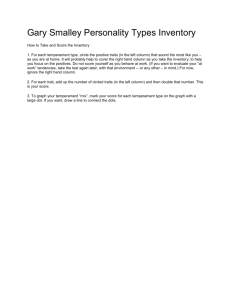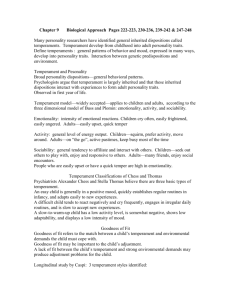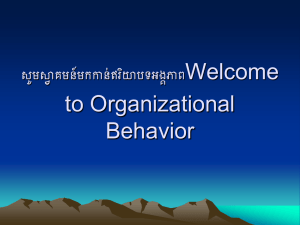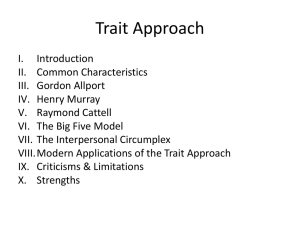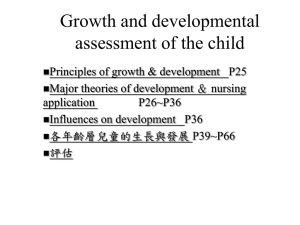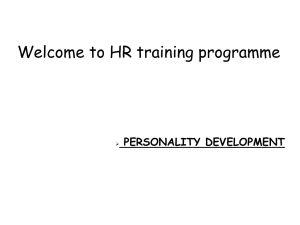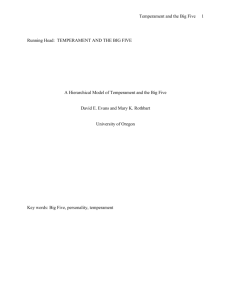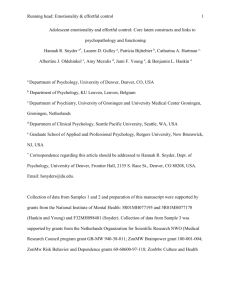Temperament and Personality in Adolescents Ruth Spence
advertisement
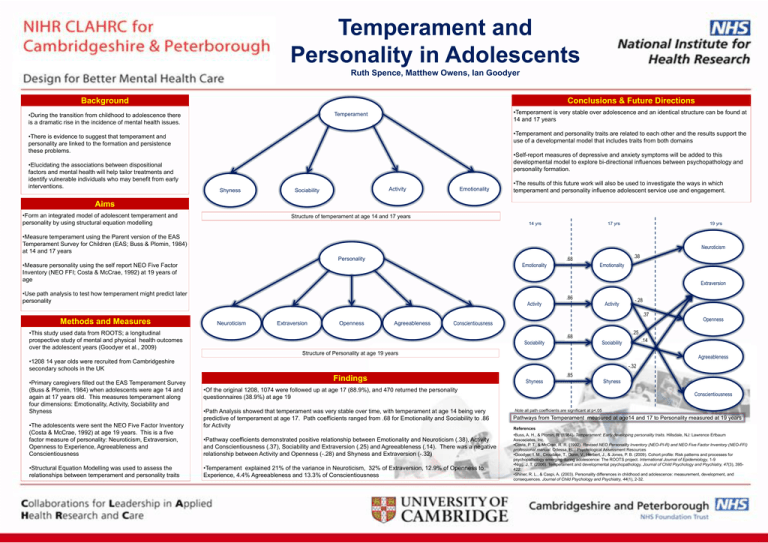
Temperament and Personality in Adolescents Ruth Spence, Matthew Owens, Ian Goodyer Background Conclusions & Future Directions •During the transition from childhood to adolescence there is a dramatic rise in the incidence of mental health issues. •Temperament is very stable over adolescence and an identical structure can be found at 14 and 17 years Temperament •Temperament and personality traits are related to each other and the results support the use of a developmental model that includes traits from both domains •There is evidence to suggest that temperament and personality are linked to the formation and persistence these problems. •Elucidating the associations between dispositional factors and mental health will help tailor treatments and identify vulnerable individuals who may benefit from early interventions. •Self-report measures of depressive and anxiety symptoms will be added to this developmental model to explore bi-directional influences between psychopathology and personality formation. Shyness Activity Sociability Emotionality •The results of this future work will also be used to investigate the ways in which temperament and personality influence adolescent service use and engagement. Aims •Form an integrated model of adolescent temperament and personality by using structural equation modelling Structure of temperament at age 14 and 17 years 14 yrs 17 yrs •Measure temperament using the Parent version of the EAS Temperament Survey for Children (EAS; Buss & Plomin, 1984) at 14 and 17 years 19 yrs Neuroticism Personality •Measure personality using the self report NEO Five Factor Inventory (NEO FFI; Costa & McCrae, 1992) at 19 years of age Emotionality .68 .38 Emotionality Extraversion •Use path analysis to test how temperament might predict later personality Activity .86 Activity -.28 .37 Methods and Measures Neuroticism Extraversion Openness Agreeableness Conscientiousness •This study used data from ROOTS; a longitudinal prospective study of mental and physical health outcomes over the adolescent years (Goodyer et al., 2009) Sociability .68 .25 .14 Sociability Structure of Personality at age 19 years Agreeableness •1208 14 year olds were recruited from Cambridgeshire secondary schools in the UK •Primary caregivers filled out the EAS Temperament Survey (Buss & Plomin, 1984) when adolescents were age 14 and again at 17 years old. This measures temperament along four dimensions: Emotionality, Activity, Sociability and Shyness •The adolescents were sent the NEO Five Factor Inventory (Costa & McCrae, 1992) at age 19 years. This is a five factor measure of personality: Neuroticism, Extraversion, Openness to Experience, Agreeableness and Conscientiousness •Structural Equation Modelling was used to assess the relationships between temperament and personality traits Openness -.32 Findings Shyness .85 •Of the original 1208, 1074 were followed up at age 17 (88.9%), and 470 returned the personality questionnaires (38.9%) at age 19 •Path Analysis showed that temperament was very stable over time, with temperament at age 14 being very predictive of temperament at age 17. Path coefficients ranged from .68 for Emotionality and Sociability to .86 for Activity •Pathway coefficients demonstrated positive relationship between Emotionality and Neuroticism (.38), Activity and Conscientiousness (.37), Sociability and Extraversion (.25) and Agreeableness (.14). There was a negative relationship between Activity and Openness (-.28) and Shyness and Extraversion (-.32) •Temperament explained 21% of the variance in Neuroticism, 32% of Extraversion, 12.9% of Openness to Experience, 4.4% Agreeableness and 13.3% of Conscientiousness Shyness Conscientiousness Note all path coefficients are significant at p<.05 Pathways from Temperament measured at age14 and 17 to Personality measured at 19 years References •Buss, A. H., & Plomin, R. (1984). Temperament: Early developing personality traits. Hillsdale, NJ: Lawrence Erlbaum Assosciates, Inc. •Costa, P. T., & McCrae, R. R. (1992). Revised NEO Personality Inventory (NEO-PI-R) and NEO Five Factor Inventory (NEO-FFI) professional manual. Odessa, FL.: Psychological Assessment Resources •Goodyer, I. M., Croudace, T., Dunn, V., Herbert, J., & Jones, P. B. (2009). Cohort profile: Risk patterns and processes for psychopathology emerging during adolescence: The ROOTS project. International Journal of Epidemiology, 1-9 •Nigg, J. T. (2006). Temperament and developmental psychopathology. Journal of Child Psychology and Psychiatry, 47(3), 395422. •Shiner, R. L., & Caspi, A. (2003). Personality differences in childhood and adolescence: measurement, development, and consequences. Journal of Child Psychology and Psychiatry, 44(1), 2-32.

